正文
浅谈Vue不同场景下组件间的数据“交流”
Vue的官方文档可以说是很详细了。在我看来,它和react等其他框架文档一样,讲述的方式的更多的是“方法论”,而不是“场景论”,这也就导致了:我们在阅读完文档许多遍后,写起代码还是不免感到有许多困惑,因为我们不知道其中一些知识点的运用场景。这就是我写这篇文章的目的,探讨不同场景下组件间的数据“交流”的Vue实现
父子组件间的数据交流
父子组件间的数据交流可分为两种:
1.父组件传递数据给子组件
2.子组件传递数据给父组件
父组件传递数据给子组件——props

这是组件数据沟通中最常见的场景:你让父组件掌握了数据源,然后传递给子组件,供子组件使用
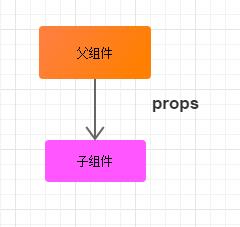
许多人会说,这很简单!用props嘛! 对,正因如此,它不是我要讲的主要内容,不过我们还是用代码简单过一遍:
父组件
<template>
<div id="father">
{{ '我是父组件' }}
<son :text = "text"></son>
</div>
</template>
<script>
import son from './son.vue'
export default {
data: function () {
return {
text: '从父组件传来的数据'
}
},
components: {
son: son
}
}
</script>
<style scoped>
</style>
子组件:
<template>
<div>
{{ '我是子组件,我接收了' + text }}
</div>
</template>
<script>
export default {
props: {
text: { type: String, default: '' }
}
}
</script>
<!-- Add "scoped" attribute to limit CSS to this component only -->
<style scoped>
</style>
demo:

在这个demo里面,我们把“从父组件传来的数据”这一个字符串通过props传递给了子组件
如果我们希望在子组件中改变父组件的数据的话,可以在父组件中定义一个能改变父组件数据的函数,然后通过props将该函数传递给子组件,并在子组件在适当时机调用该函数——从而起到在子组件中改变父组件数据的效果
子组件传递数据给父组件
子组件传递数据给父组件 方式一:回调传参

父组件:
<template>
<div id="father">
{{ '我是父组件,名称是' + componentName }}
<son :changeComponentName = "changeComponentName"></son>
</div>
</template>
<script>
import son from './son.vue'
export default {
data: function () {
return {
componentName: '组件A'
}
},
methods: {
changeComponentName: function (newComponentName) {
this.componentName = newComponentName
}
},
components: {
son: son
}
}
</script>
<style scoped>
#father div{
padding: 10px;
margin: 10px;
border: 1px solid gray;
}
</style>
子组件:
<template>
<div>
<p>我是子组件:一个button</p>
<button @click="() => changeComponentName(newComponentName)">
把父组件的名称修改为:彭湖湾的组件
</button>
</div>
</template>
<script>
export default {
data: function () {
return {
newComponentName: '彭湖湾的组件'
}
},
props: {
changeComponentName: {
type: Function,
default: () => { }
}
}
}
</script>
<!-- Add "scoped" attribute to limit CSS to this component only -->
<style scoped>
</style>
demo:
点击前:
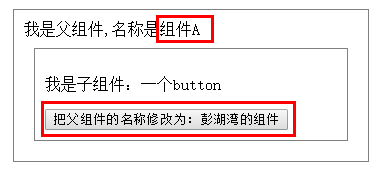
点击后:
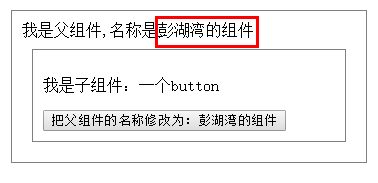
图解:
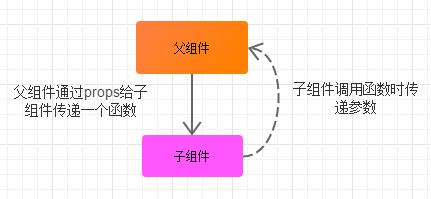

点击子组件(按钮)的时候,将父组件的名称从“A”修改为“彭湖湾的组件”
我们从父组件向子组件传递了一个函数(changeComponentName)。并在子组件调用这个函数的时候,以参数的形式传递了一个子组件内部的数据(newComponentName)给这个函数,这样,在父组件中定义的函数(changeComponentName)就可以取得子组件传来的参数了
【PS】 命名太长不好意思
子组件传递数据给父组件 方式二:自定义事件

父组件:
<template>
<div id="father">
<div>
{{ '我是父组件,我的名称是:' + fatherComponentName }}
<son v-on:changeComponentName = "changeComponentName"></son>
</div>
</div>
</template>
<script>
import son from './son.vue'
export default {
data: function () {
return {
fatherComponentName: 'A组件'
}
},
methods: {
changeComponentName: function (componentName) {
this.fatherComponentName = componentName
}
},
components: {
son: son
}
}
</script>
<style scoped>
#father div{
padding: 10px;
margin: 10px;
border:1px solid grey;
}
</style>
子组件:
<template>
<div>
<p>我是子组件:一个按钮</p>
<button @click="clickCallback">
修改父组件的名称为:彭湖湾的组件
</button>
</div>
</template>
<script>
export default {
data: function () {
return {
fatherComponentName: '彭湖湾的组件'
}
},
methods: {
clickCallback: function () {
this.$emit('changeComponentName', this.fatherComponentName)
}
}
}
</script>
<!-- Add "scoped" attribute to limit CSS to this component only -->
<style scoped>
</style>
demo:
点击前:
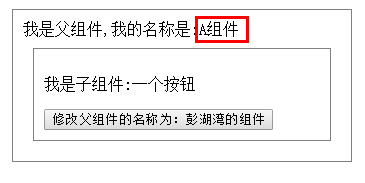
点击后:

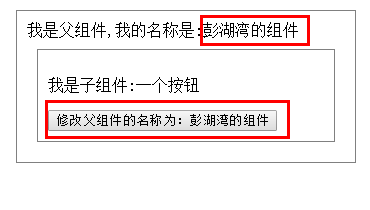
图解:
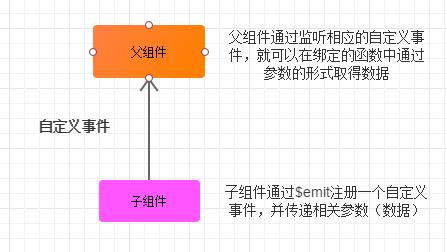
通过$emit(event, [...参数]),所有的参数将被传递给监听器回调,也就是我们在父组件中定义的changeComponentName方法,从而实现从子组件中给父组件传参
兄弟组件间的数据交流(有共同父组件的兄弟组件)

父组件:
<template>
<div id="father">
<div>
{{ '我是父组件:father' }}
<eldest-son :text = "text"></eldest-son>
<youngest-son :changeText="changeText"></youngest-son>
</div>
</div>
</template>
<script>
import eldestSon from './eldestSon.vue'
import youngestSon from './youngestSon.vue'
export default {
data: function () {
return {
text: '我是一行文本'
}
},
methods: {
changeText: function () {
this.text = '我是经过改动的一行文本'
}
},
components: {
eldestSon: eldestSon,
youngestSon: youngestSon
}
}
</script>
<style>
#father div{
border: 1px solid grey;
padding: 10px;
margin: 10px;
}
</style>
兄弟组件1:
<template>
<div>
<p>我是兄弟组件:eldestSon</p>
<p>我有一个可变数据text:{{ text }}</p>
</div>
</template>
<script>
export default {
props: {
text: {
type: String,
default: ''
}
}
}
</script>
<!-- Add "scoped" attribute to limit CSS to this component only -->
<style scoped>
</style>
兄弟组件2:
<template>
<div>
<p>我是兄弟组件:youngestSon</p>
<button @click="changeText">更改eldestSon兄弟组件中的文本</button>
</div>
</template>
<script>
export default {
props: {
changeText: {
type: Function,
default: () => {}
}
}
}
</script>
<!-- Add "scoped" attribute to limit CSS to this component only -->
<style scoped>
</style>
点击前:


点击后:
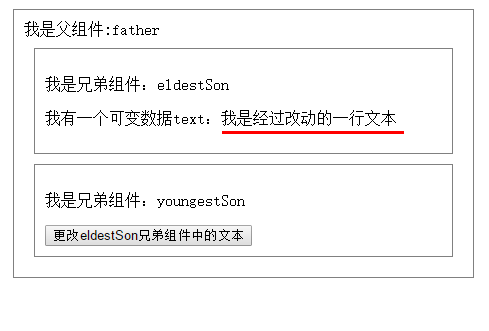
图解:


如果两个兄弟组件间存在这种数据关系的话,我们可以尝试寻找其共同的父组件,使数据和相关方法“提升”到父组件内部,并向下传给两个子组件
这样,其中一个子组件取得了数据,另外一个子组件取得了改变数据的方法,便可以实现上述的数据沟通
【注意】这种场景存在局限性,它要求两个组件有共同父组件。对于这种场景之外的处理方法,请看下文
全局组件间的数据交流——Vuex
我上述的许多场景里面,都运用到了props或者函数传参的方式去处理组件间的数据沟通。然而在稍大型的应用里面,它们都不约而同地给我们带来了很大的麻烦
例如:
1.通过props从父组件向子组件传递数据
对于直接的父子关系的组件,数据流显得很简洁明确,但在大型应用里面,我们上下嵌套许多个组件的时候,这就会导致我们的代码非常地繁琐,并难以维护
2.对于没有共同的父组件的兄弟组件,函数传参的数据传递方式也无能为力了,Vue文档里介绍到,你可以通过以$emit和$on函数为基础的“事件总线”沟通数据,但它无法应对更加大型的应用
这个时候Vuex就成为了实现全局组件间数据交流的最佳方案了

Vuex拥有一个包含全部顶层状态的单一数据源(state)
1.所有的组件都可以使用这个单一数据源里面的数据
2.所有的组件都可以通过派发 动作(actions)修改这个单一数据源里的数据
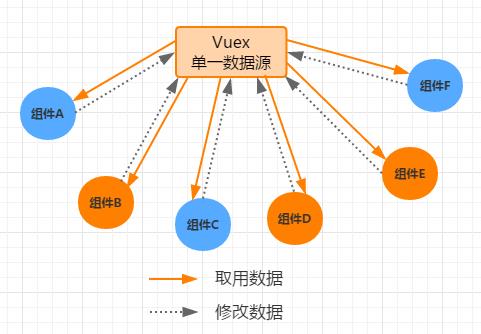
原本要“走很多弯路”才能实现沟通的数据流,一下子就找到了最短的捷径
实现View层的数据和model层的解耦
在1,2小节中处理的数据(Vue)和第三小节中处理的数据(Vuex),在很多时候是两种不同类型的数据,前者是属于View层,仅负责单纯的UI展示,而model层的大多是从后端取得后注入的数据。
一点建议:
1.Vue部分的代码负责构建View层
2.Vuex部分的代码负责构建model层
(上述的Vue指的是Vuex之外的框架体系)
以上述两点为基础,决定某部分的代码到底要写进Vue里面还是写进Vuex里面,并尽量将两者分开,从而实现View层和model层的解耦,提高前端代码的可维护性和扩展性
